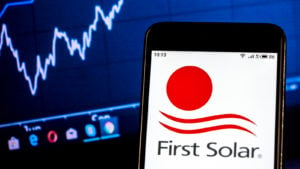First Solar (NASDAQ:FSLR) manufactures top-notch modules that are selling fairly well, and it is one of the highest quality companies in the solar sector. Still, First Solar stock shouldn’t be your first choice.

Given the company’s dependency on the U.S. market, there are much better solar space opportunities for risk-tolerant, growth investors than FSLR stock.
As of Aug. 6, First Solar expected to ship 11.9 gigawatts of solar modules through Aug. 20, versus the 11.7 gigawatts of modules that it shipped all of last year.
That certainly indicates strong demand despite the pandemic.
A Closer Look at First Solar Stock
The company’s Q2 revenue climbed $110 million quarter-over-quarter and came in ahead of analysts’ average outlook.
Even though the increase was mainly due to the company’s sale of a solar project, the fact that First Solar was able to raise its top line in the midst of the pandemic was positive.
Perhaps more important, the company maintained its 2020 module-production guidance and, provided impressive module-sales guidance.
Further, according to PVSolar, First Solar’s Series 6 modules are the most sustainable in the industry. Last month, the company decided to enter the distributed-solar market for the first time, giving it a new, potent growth engine.
Finally, in August 2019, indicating that the company is one of the strongest in the sector from a financial standpoint, PV Tech identified it as one of the four most “bankable PV module suppliers” in the world.
North American Exposure
In August 2020, First Solar estimated that about 75% of its potential booking opportunities were in North America. While I’m upbeat about solar’s outlook in the U.S., I’m much more bullish on its prospects in other places, namely China, Europe, and the Persian Gulf region.
China and Europe both recently unveiled new carbon-emission-reduction goals.
China has pledged to become carbon-neutral by 2060, while the EU Parliament has voted to mandate a 60% cut in the EU’s carbon emissions by 2029.
The bloc’s executive branch, the European Commission, has proposed a 55% reduction, up from 40% previously. The EU’s 27 countries will make the final call, but it’s a pretty good bet that the final number will come in between 55% and 60%.
Finally, in the Persian Gulf, Saudi Arabia is looking to produce 50 percent of its electricity from renewable sources by 2030. A number of its neighbors have launched sizable solar initiatives.
By contrast, in the U.S. President Donald Trump has taken America out of the Paris Climate Accord and effectively weakened the Obama-era Clean Power Plan.
I think that the Democrats’ chances of capturing both the White House and Senate are weaker than many believe. Further, even if there is a “blue wave,” red states could successfully use litigation to prevent the Democrats from enacting sweeping carbon-reduction mandates.
Given First Solar’s lack of large-scale exposure to these regions, it’s not surprising that analysts, on average, only expect its revenue to increase 11% next year.
Conversely, analysts’ average revenue estimate for JinkoSolar (NYSE:JKS), which has large exposure to both the Chinese and European markets, calls for its top line to surge over 20% in 2021.
The Bottom Line on First Solar Stock
Given First Solar’s lack of exposure to the regions where solar is likely to grow the fastest in the longer-term, risk-tolerant, growth investors should avoid the name.
Instead, such investors should buy the shares of JinkoSolar, Canadian Solar (NASDAQ:CSIQ), and Daqo New Energy (NYSE:DQ) which do have significant exposure to one or more of those regions.
However, First Solar’s balance sheet is meaningfully better than those of the other companies I named.
The company has a current ratio of 3.66, versus 1.04, 1.14, and 0.47 for JinkoSolar, Canadian Solar and Daqo, respectively.
In general, higher current ratios indicate greater financial solvency, and firms with current ratios below one could theoretically face liquidity issues in the near-term to medium-term.
Consequently, risk-averse investors who want exposure to the solar sector should considering buying First Solar stock.
On the date of publication, Larry Ramer held long positions in JinkoSolar and Daqo New Energy.
Larry has conducted research and written articles on U.S. stocks for 13 years. He has been employed by The Fly and Israel’s largest business newspaper, Globes. Among his highly successful contrarian picks have been solar stocks, Roku, Plug Power, solar stocks, and Snap. You can reach him on StockTwits at @larryramer. Larry began writing columns for InvestorPlace in 2015.
